The thermoexpandable polymer microsphere market, valued at USD 189.6 million in 2025 and expected to reach USD 300.1 million by 2035 at a CAGR of 4.7%, shows clear supply-side dynamics that determine the pace and efficiency of growth across end-use sectors. Raw material sourcing is one of the most important elements, as production relies on specialized polymers such as acrylonitrile copolymers, vinylidene chloride, and other monomers. Feedstock availability and price stability influence the economics of microsphere production, with volatility in petrochemical markets creating both risks and opportunities for manufacturers. Suppliers that are vertically integrated or have long-term contracts with polymer producers are better positioned to maintain consistent supply and protect margins.
Production capacity is another critical factor. Thermoexpandable polymer microspheres require precise processing environments with advanced polymerization, encapsulation, and expansion control technologies. Investment in automated reactors, quality monitoring systems, and advanced extrusion equipment enables suppliers to scale output without compromising uniformity in particle size or expansion performance. Companies that invest in modular production lines gain flexibility to meet demand spikes from sectors such as electronics or automotive. Technological leadership in uniform expansion properties and low-temperature activation is increasingly viewed as a differentiator on the supply side.
Geographic concentration of supply adds another layer. Asia Pacific is emerging as a key hub for microsphere production, with China, Japan, and South Korea benefiting from their strong polymer and electronics manufacturing bases. Europe continues to serve as a source of premium grades, especially for automotive and coatings applications, while North American suppliers focus on high-performance formulations and partnerships with industrial users. This regional clustering of production also affects logistics and cost competitiveness, with proximity to electronics and automotive manufacturing centers offering a decisive supply-side advantage. The competitive landscape is moderately consolidated, with established specialty chemical companies holding technological expertise and proprietary formulations that act as entry barriers. Supply is increasingly tied to partnerships with OEMs, where long-term contracts ensure steady offtake and reduce exposure to price volatility. Smaller players often compete through regional distribution strength and customized solutions, but scaling challenges limit their ability to compete with larger suppliers in global markets.
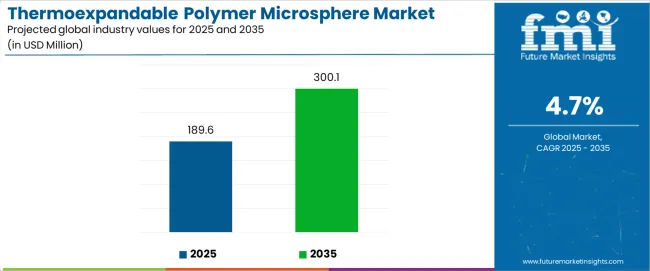
| Period | Primary Revenue Buckets | Share | Notes |
|---|---|---|---|
| Today | Acrylonitrile-based microspheres (industrial applications) | 52% | Traditional polymer chemistry, established manufacturing |
| Acrylic acid-based systems | 38% | Enhanced expansion properties, electronics applications | |
| Specialty polymer formulations | 10% | High-performance applications, medical devices | |
| Future (3-5 yrs) | Advanced acrylonitrile systems | 45-48% | Enhanced expansion control, precision manufacturing |
| High-performance acrylic systems | 25-28% | Electronics miniaturization, automotive applications | |
| Industrial processing applications | 12-15% | Manufacturing automation, thermal management | |
| Electronics & semiconductor applications | 8-12% | Advanced packaging, thermal interface materials | |
| Medical device applications | 6-10% | Biocompatible formulations, drug delivery systems | |
| Automotive & aerospace applications | 4-7% | Lightweight materials, thermal expansion solutions |
| Metric | Value |
|---|---|
| Market Value (2025) | USD 189.6 million |
| Market Forecast (2035) | USD 300.1 million |
| Growth Rate | 4.7% CAGR |
| Leading Material | Acrylonitrile Type |
| Primary Application | Industrial Segment |
The market demonstrates strong fundamentals with acrylonitrile-based microsphere systems capturing a dominant share through advanced polymer expansion properties and industrial application optimization. Industrial applications drive primary demand, supported by increasing manufacturing automation requirements and electronics industry modernization initiatives. Geographic expansion remains concentrated in developed markets with established manufacturing infrastructure, while emerging economies show accelerating adoption rates driven by industrial modernization initiatives and rising technical performance standards.
Design for precision expansion control, not just basic functionality
Primary Classification: The market segments by material type into acrylonitrile, acrylic acid, and others, representing the evolution from traditional polymer chemistries to sophisticated formulation systems for comprehensive thermal expansion optimization.
Secondary Classification: Application segmentation divides the market into industrial, electronics, medical, and others, reflecting distinct requirements for expansion performance, processing conditions, and technical specifications.
Tertiary Classification: End-use segmentation covers manufacturing facilities, electronics companies, automotive manufacturers, medical device companies, and research institutions, while distribution channels span direct sales, specialty chemical distributors, and technical material suppliers.
Regional Classification: Geographic distribution covers North America, Latin America, Western Europe, Eastern Europe, East Asia, South Asia Pacific, and Middle East & Africa, with developed markets leading adoption while emerging economies show accelerating growth patterns driven by industrial modernization programs.
The segmentation structure reveals material progression from traditional acrylonitrile microspheres toward sophisticated polymer blend systems with enhanced expansion capabilities, while application diversity spans from basic industrial uses to precision electronics requiring advanced thermal management solutions.
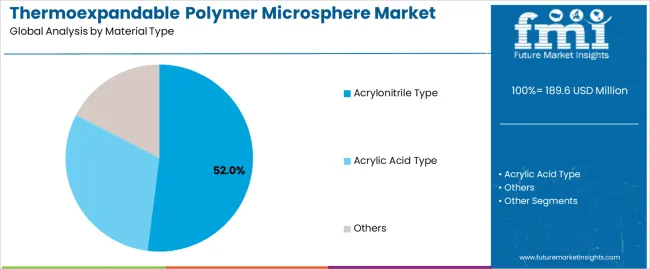
Market Position: Acrylonitrile microsphere systems command the leading position in the thermoexpandable polymer microsphere market with 52% market share through proven polymer technologies, including controlled expansion characteristics, thermal stability properties, and processing optimization that enable manufacturing operators to achieve optimal material performance across diverse industrial and electronics environments.
Value Drivers: The segment benefits from manufacturing industry preference for established microsphere systems that provide reliable expansion control, consistent performance characteristics, and processing compatibility without requiring specialized handling infrastructure. Advanced acrylonitrile processing features enable enhanced expansion precision, temperature stability, and integration with existing manufacturing processes, where expansion performance and material reliability represent critical operational requirements.
Competitive Advantages: Acrylonitrile microsphere systems differentiate through proven expansion reliability, established polymer chemistry, and integration with standard manufacturing systems that enhance facility effectiveness while maintaining optimal technical performance suitable for diverse industrial applications.
Key market characteristics:
Acrylic acid microsphere systems maintain a 38% market position in the thermoexpandable polymer microsphere market due to their enhanced expansion characteristics and specialized application benefits. These materials appeal to facilities requiring advanced microsphere solutions with superior expansion profiles for high-performance operations. Market growth is driven by electronics industry expansion, emphasizing precision expansion solutions and operational efficiency through optimized polymer designs.
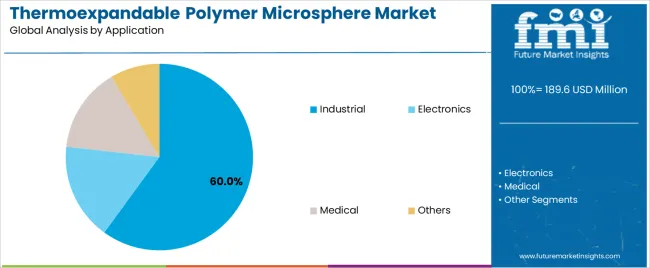
Market Context: Industrial applications demonstrate strong growth in the thermoexpandable polymer microsphere market with 60% market share due to widespread adoption of advanced manufacturing processes and increasing focus on material performance optimization, operational cost efficiency, and thermal management applications that maximize microsphere effectiveness while maintaining processing standards.
Appeal Factors: Industrial operators prioritize microsphere reliability, expansion consistency, and integration with existing manufacturing infrastructure that enables coordinated material operations across multiple processing departments. The segment benefits from substantial manufacturing industry investment and automation programs that emphasize the acquisition of premium microspheres for process optimization and performance enhancement applications.
Growth Drivers: Industrial expansion programs incorporate thermoexpandable microspheres as essential components for manufacturing operations, while advanced processing growth increases demand for microsphere capabilities that comply with technical standards and minimize operational complexity.
Market Challenges: Varying processing requirements and operational scale complexity may limit microsphere standardization across different facilities or application scenarios.
Application dynamics include:
Electronics applications capture 32% market share through specialized miniaturization requirements in semiconductor packaging, electronic components, and high-tech applications. These facilities demand precision microspheres capable of supporting technical requirements while providing thermal management access and processing compatibility capabilities.
Medical applications account for 18% market share, including medical devices, pharmaceutical applications, and biocompatible systems requiring performance microsphere capabilities for safety optimization and regulatory compliance.
Market Context: Manufacturing Facilities dominate the market with 5.2% CAGR, reflecting the primary demand source for thermoexpandable polymer microsphere technology in industrial applications and process optimization.
Business Model Advantages: Manufacturing Facilities provide direct market demand for standardized microsphere systems, driving volume production and cost optimization while maintaining quality control and performance consistency requirements.
Operational Benefits: Manufacturing Facility applications include process standardization, cost efficiency, and quality assurance that drive consistent demand for microsphere systems while providing access to latest polymer technologies.
| Category | Factor | Impact | Why It Matters |
|---|---|---|---|
| Driver | Electronics miniaturization & advanced manufacturing (semiconductor packaging, thermal management) | ★★★★★ | Growing electronics market requires precision microspheres with enhanced expansion capabilities and thermal properties proven effective across manufacturing applications. |
| Driver | Industrial automation advancement & processing optimization (quality control, performance enhancement) | ★★★★★ | Transforms microsphere requirements from "basic materials" to "precision components"; operators that offer advanced microspheres and technical features gain competitive advantage. |
| Driver | High-performance applications growth & technical excellence (automotive, aerospace) | ★★★★☆ | Advanced industries need specialized, high-quality microspheres; demand for exclusive and superior microsphere solutions expanding addressable market. |
| Restraint | Raw material costs & supply chain constraints (especially for specialty polymers) | ★★★★☆ | Smaller manufacturers defer microsphere upgrades; increases price sensitivity and slows premium microsphere adoption in cost-conscious markets. |
| Restraint | Alternative material options competition (conventional fillers, foam systems) | ★★★☆☆ | Standard material alternatives offer established supply chains and lower costs, potentially limiting microsphere adoption in traditional applications. |
| Trend | Polymer technology integration & performance enhancement (controlled expansion, thermal stability) | ★★★★★ | Advanced polymer properties, expansion optimization, and performance analytics transform operations; technology integration and performance enhancement become core value propositions. |
| Trend | Customization & application-specific solutions (formulation optimization, processing parameters) | ★★★★☆ | Custom microspheres for specific applications and industries; specialized formulations and targeted performance capabilities drive competition toward customization solutions. |
The thermoexpandable polymer microsphere market demonstrates varied regional dynamics with Growth Leaders including China (6.3% growth rate) and India (5.9% growth rate) driving expansion through industrial development initiatives and manufacturing modernization. Steady Performers encompass Germany (5.4% growth rate), Brazil (4.9% growth rate), and developed regions, benefiting from established manufacturing industries and advanced material adoption. Mature Markets feature United States (4.5% growth rate), United Kingdom (4.0% growth rate), and Japan (3.5% growth rate), where industrial advancement and technical standardization requirements support consistent growth patterns.
Regional synthesis reveals East Asian markets leading adoption through manufacturing expansion and industrial development, while North American countries maintain steady expansion supported by microsphere technology advancement and technical standardization requirements. European markets show strong growth driven by industrial applications and quality integration trends.
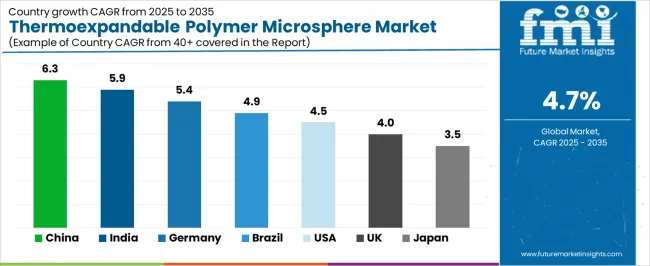
| Region/Country | 2025-2035 Growth | How to win | What to watch out |
|---|---|---|---|
| China | 6.3% | Focus on high-volume production solutions | Regulatory changes; local competition |
| India | 5.9% | Lead with cost-effective manufacturing | Import restrictions; quality barriers |
| Germany | 5.4% | Provide premium quality microspheres | Over-regulation; lengthy approvals |
| Brazil | 4.9% | Offer value-oriented solutions | Currency fluctuations; import duties |
| United States | 4.5% | Push technology integration | Compliance costs; scaling challenges |
| United Kingdom | 4.0% | Focus on premium applications | Economic impacts; material costs |
| Japan | 3.5% | Emphasize precision manufacturing | Traditional preferences; adoption rates |
China establishes fastest market growth through aggressive industrial development programs and comprehensive manufacturing infrastructure expansion, integrating advanced thermoexpandable microsphere systems as standard components in electronics facilities and industrial installations. The country's 6.3% growth rate reflects government initiatives promoting manufacturing modernization and domestic microsphere capabilities that mandate the use of advanced material systems in electronics and industrial facilities. Growth concentrates in major manufacturing hubs, including Guangdong, Jiangsu, and Zhejiang, where industrial development showcases integrated microsphere systems that appeal to manufacturers seeking performance optimization capabilities and processing applications.
Chinese manufacturers are developing cost-effective microsphere solutions that combine domestic production advantages with advanced polymer features, including enhanced expansion control and improved processing capabilities. Distribution channels through industrial suppliers and specialty chemical distributors expand market access, while government support for manufacturing development supports adoption across diverse electronics and industrial segments.
Strategic Market Indicators:
In Mumbai, Bangalore, and Chennai, manufacturing facilities and industrial operators are implementing thermoexpandable microsphere systems as standard materials for processing optimization and performance enhancement applications, driven by increasing government industrial investment and manufacturing modernization programs that emphasize the importance of advanced material capabilities. The market holds a 5.9% growth rate, supported by government industrial initiatives and technology development programs that promote advanced microsphere systems for manufacturing and electronics facilities. Indian operators are adopting microsphere systems that provide consistent processing performance and expansion features, particularly appealing in industrial regions where material performance and operational excellence represent critical business requirements.
Market expansion benefits from growing manufacturing capabilities and international technology partnerships that enable domestic production of advanced microsphere systems for industrial and electronics applications. Technology adoption follows patterns established in specialty chemicals, where reliability and performance drive procurement decisions and operational deployment.
Market Intelligence Brief:
Germany's advanced manufacturing market demonstrates sophisticated thermoexpandable microsphere deployment with documented performance effectiveness in industrial applications and electronics facilities through integration with existing manufacturing systems and process infrastructure. The country leverages engineering expertise in polymers and materials systems integration to maintain a 5.4% growth rate. Manufacturing centers, including Baden-Württemberg, North Rhine-Westphalia, and Bavaria, showcase premium installations where microsphere systems integrate with comprehensive manufacturing platforms and process control systems to optimize material performance and operational effectiveness.
German manufacturers prioritize system quality and EU compliance in microsphere development, creating demand for premium systems with advanced features, including process integration and performance monitoring systems. The market benefits from established manufacturing infrastructure and a willingness to invest in advanced microsphere technologies that provide long-term operational benefits and compliance with international manufacturing standards.
Market Intelligence Brief:
Brazil's market expansion benefits from diverse industrial demand, including manufacturing modernization in São Paulo and Rio de Janeiro, facility upgrades, and government industrial programs that increasingly incorporate thermoexpandable microsphere solutions for processing applications. The country maintains a 4.9% growth rate, driven by rising manufacturing activity and increasing recognition of advanced microsphere benefits, including precise expansion control and enhanced operational effectiveness.
Market dynamics focus on cost-effective microsphere solutions that balance processing performance with affordability considerations important to Brazilian manufacturing operators. Growing industrial development creates continued demand for modern microsphere systems in new manufacturing infrastructure and facility modernization projects.
Strategic Market Considerations:
United States establishes market leadership through comprehensive manufacturing programs and advanced industrial infrastructure development, integrating thermoexpandable microsphere systems across electronics and industrial applications. The country's 4.5% growth rate reflects established manufacturing industry relationships and mature microsphere technology adoption that supports widespread use of advanced material systems in electronics and industrial facilities. Growth concentrates in major manufacturing centers, including California, Texas, and the Midwest, where microsphere technology showcases mature deployment that appeals to manufacturers seeking proven performance capabilities and processing efficiency applications.
American manufacturing providers leverage established distribution networks and comprehensive technical support capabilities, including application engineering and testing support that create customer relationships and operational advantages. The market benefits from mature regulatory standards and manufacturing requirements that mandate microsphere system use while supporting technology advancement and operational optimization.
Market Intelligence Brief:
United Kingdom's manufacturing market demonstrates integrated thermoexpandable microsphere deployment with documented performance effectiveness in industrial applications and electronics facilities through integration with existing manufacturing systems and process infrastructure. The country maintains a 4.0% growth rate, supported by manufacturing excellence programs and performance effectiveness requirements that promote advanced microsphere systems for industrial applications. Manufacturing facilities across England, Scotland, and Wales showcase systematic installations where microsphere systems integrate with comprehensive manufacturing platforms to optimize material performance and operational outcomes.
UK manufacturing providers prioritize system reliability and industry compatibility in microsphere procurement, creating demand for validated systems with proven performance features, including quality monitoring integration and processing optimization systems. The market benefits from established manufacturing infrastructure and excellence requirements that support microsphere technology adoption and operational effectiveness.
Market Intelligence Brief:
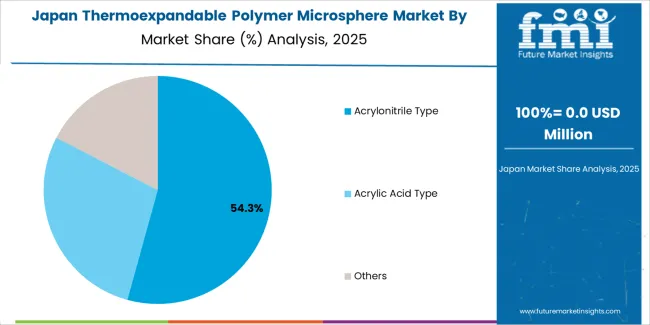
Japan's market growth benefits from precision manufacturing demand, including advanced electronics facilities in Tokyo and Osaka, quality integration, and technology enhancement programs that increasingly incorporate microsphere solutions for performance applications. The country maintains a 3.5% growth rate, driven by manufacturing technology advancement and increasing recognition of precision microsphere benefits, including accurate expansion control and enhanced processing outcomes.
Market dynamics focus on high-precision microsphere solutions that meet Japanese quality standards and performance effectiveness requirements important to manufacturing operators. Advanced manufacturing technology adoption creates continued demand for sophisticated microsphere systems in electronics facility infrastructure and process modernization projects.
Strategic Market Considerations:
The European thermoexpandable polymer microsphere market is projected to grow from USD 42.1 million in 2025 to USD 68.4 million by 2035, registering a CAGR of 5.0% over the forecast period. Germany is expected to maintain its leadership position with a 41.3% market share in 2025, supported by its advanced manufacturing infrastructure and major industrial centers.
United Kingdom follows with a 26.8% share in 2025, driven by comprehensive manufacturing programs and industrial excellence development initiatives. France holds a 16.2% share through specialized industrial applications and manufacturing compliance requirements. Italy commands a 9.7% share, while Spain accounts for 6.0% in 2025. The rest of Europe region is anticipated to gain momentum, expanding its collective share from 3.6% to 4.1% by 2035, attributed to increasing manufacturing adoption in Nordic countries and emerging industrial facilities implementing modernization programs.
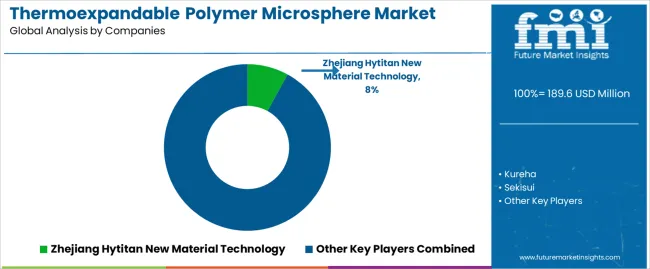
| Stakeholder | What they actually control | Typical strengths | Typical blind spots |
|---|---|---|---|
| Global brands | Distribution reach, broad product catalogs, technical recognition | Wide availability, proven quality, multi-region support | Product refresh cycles; customer dependency on technical validation |
| Technology innovators | Polymer R&D; advanced material technologies; enhanced expansion properties | Latest technologies first; attractive ROI on performance effectiveness | Service density outside core regions; scaling complexity |
| Regional specialists | Local compliance, fast delivery, nearby customer support | "Close to customer" support; pragmatic pricing; local regulations | Technology gaps; talent retention in technical service |
| Full-service providers | Material programs, technical services, application engineering | Lowest operational risk; comprehensive support | Service costs if overpromised; technology obsolescence |
| Niche specialists | Specialized applications, custom formulations, technical services | Win premium applications; flexible configurations | Scalability limitations; narrow market focus |
| Item | Value |
|---|---|
| Quantitative Units | USD 189.6 million |
| Material Type | Acrylonitrile Type, Acrylic Acid Type, Others |
| Application | Industrial, Electronics, Medical, Others |
| End Use | Manufacturing Facilities, Electronics Companies, Automotive Manufacturers, Medical Device Companies, Research Institutions |
| Regions Covered | North America, Latin America, Western Europe, Eastern Europe, East Asia, South Asia Pacific, Middle East & Africa |
| Countries Covered | China, India, Germany, Brazil, United States, United Kingdom, Japan, Canada, France, Australia, and 25+ additional countries |
| Key Companies Profiled | Zhejiang Hytitan New Material Technology, Kureha, Sekisui, Nouryon, Matsumoto Yushi-Seiyaku, Jinlang Dongjin Semichem, Chase Corporation, Hunan Farida, YUNYAN Materials |
| Additional Attributes | Dollar sales by material type and application categories, regional adoption trends across East Asia, North America, and Western Europe, competitive landscape with polymer manufacturers and specialty chemical suppliers, manufacturing operator preferences for microsphere effectiveness and processing performance, integration with manufacturing platforms and quality control systems, innovations in polymer technology and microsphere enhancement, and development of advanced microsphere solutions with enhanced expansion and operational optimization capabilities. |
The global thermoexpandable polymer microsphere market is estimated to be valued at USD 189.6 million in 2025.
The market size for the thermoexpandable polymer microsphere market is projected to reach USD 300.1 million by 2035.
The thermoexpandable polymer microsphere market is expected to grow at a 4.7% CAGR between 2025 and 2035.
The key product types in thermoexpandable polymer microsphere market are acrylonitrile type, acrylic acid type and others.
In terms of application, industrial segment to command 60.0% share in the thermoexpandable polymer microsphere market in 2025.






Full Research Suite comprises of:
Market outlook & trends analysis
Interviews & case studies
Strategic recommendations
Vendor profiles & capabilities analysis
5-year forecasts
8 regions and 60+ country-level data splits
Market segment data splits
12 months of continuous data updates
DELIVERED AS:
PDF EXCEL ONLINE
Polymer Stabilizers Market Size and Share Forecast Outlook 2025 to 2035
Polymeric Adsorbents Market Size and Share Forecast Outlook 2025 to 2035
Polymerization Initiator Market Size and Share Forecast Outlook 2025 to 2035
Polymer Processing Aid (PPA) Market Size and Share Forecast Outlook 2025 to 2035
Polymer Feed System Market Size and Share Forecast Outlook 2025 to 2035
Polymer Bearings Market Size and Share Forecast Outlook 2025 to 2035
Polymer Surge Arrester Market Size and Share Forecast Outlook 2025 to 2035
Polymer Nanomembrane Market Size and Share Forecast Outlook 2025 to 2035
Polymeric Sand Market Analysis - Size, Share, and Forecast Outlook 2025 to 2035
Polymer Binders Market Size and Share Forecast Outlook 2025 to 2035
Polymer Emulsions Market Size and Share Forecast Outlook 2025 to 2035
Polymer Memory Market Size and Share Forecast Outlook 2025 to 2035
Polymer Gel Market Size and Share Forecast Outlook 2025 to 2035
Polymeric Microcapsules Market Size and Share Forecast Outlook 2025 to 2035
Polymer Fillers Market Analysis - Size, Share, and Forecast 2025 to 2035
Polymer Coated Fabrics Market Trends 2025 to 2035
Polymer Emulsion Market Growth - Trends & Forecast 2025 to 2035
Polymeric Membrane Market Growth - Trends & Forecast 2025 to 2035
Polymer Vials Market Insights & Industry Growth 2025 to 2035
Polymer Seals Market Growth – Trends & Forecast 2025 to 2035

Thank you!
You will receive an email from our Business Development Manager. Please be sure to check your SPAM/JUNK folder too.
Chat With
MaRIA